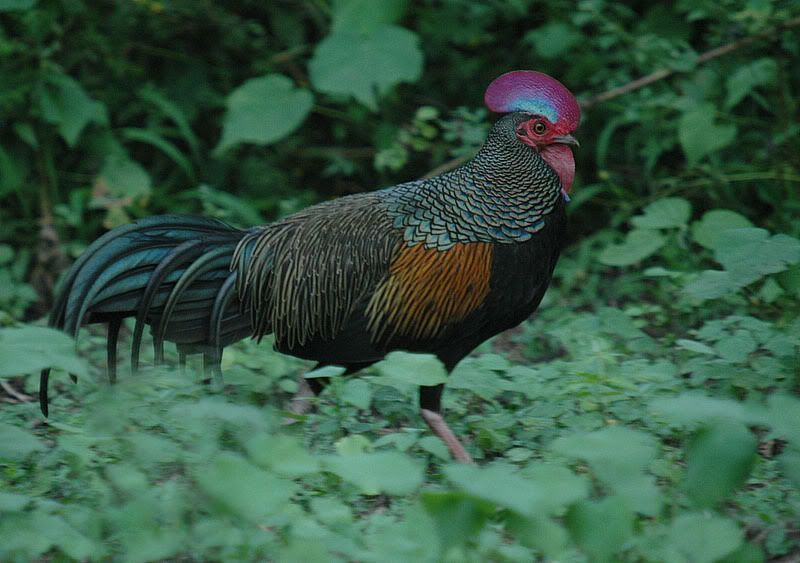Quote:
How long do you figure this patient method will take. I'm in no hurry, just wondering. You have Cemani stock?
Once we have Ayam Kedu- and let's revisit this issue-
You don't need the Ayam Cemani- you need Ayam Pelung Kedu. From the Ayam Kedu one reaches the Cemani and since the black bones and flesh of this subbreed are but one attribute, selecting for hypermelanism before there is a proper frame upon which to apply the ink stained tissue- you've just entered into yet another counter-productive poultry selective breeding initiative.
Recreating a mirror strain of Ayam Kedu is not difficult, especially with the inclusion of W.C. Lawrence's aforementioned stocks.
What's important is to make sure that the founders of the first next generation recombines Shamo and Sumatran; JF/Longtail, Tomaru and Black Java.
As W.C. has all that stock - much of it already recombined, there's a good 30% along the way. Once there is a composite of the above breeds- and by composite- we need four generations- bred interese- that is sibling to sibling until each individual in the founding group contains Shamo- Sumatran, JF/Longtail, Tomaru and Black Java- and nothing else-
That's only two years tops.
The most ideal birds that meet the ideal carriage, height and length of body and leg- these are selected for, together with very dark females.
Once there are mirror phenotypes of the Ayam Kedu breeding the stock that actually contains Kedu genetics = some birds that contain 75% of the alleles necessary to generate Ayam Kedu.
Yes. I have some stock that are primarily Ayam Kedu recombined with Toh Tenko. They look like Kedu with oversized combs and wattles. They are white skinned.
Before I had them they were being bred towards a specific ideal- t "Manzanar". Very tall, large birds of light to medium weight about the size of standard Paduan.
Most are black, many birchen and a few are blueish grey. The Kedu/Cemani was used to increase the comb height and number of serrations.
As the Nippon-ized Kedu already exist all that is needed is the recombination I've discussed here.
That is- the Manzanar could be used to provide the really difficult carriage, the voice, the long body- all that careful selective breeding that went into Kedu- its all there-
That in itself is thirty or forty years of work already completed.
The composite I've discussed bred to the Manzanar- all together five years at the longest
How long do you figure this patient method will take. I'm in no hurry, just wondering. You have Cemani stock?
Once we have Ayam Kedu- and let's revisit this issue-
You don't need the Ayam Cemani- you need Ayam Pelung Kedu. From the Ayam Kedu one reaches the Cemani and since the black bones and flesh of this subbreed are but one attribute, selecting for hypermelanism before there is a proper frame upon which to apply the ink stained tissue- you've just entered into yet another counter-productive poultry selective breeding initiative.
Recreating a mirror strain of Ayam Kedu is not difficult, especially with the inclusion of W.C. Lawrence's aforementioned stocks.
What's important is to make sure that the founders of the first next generation recombines Shamo and Sumatran; JF/Longtail, Tomaru and Black Java.
As W.C. has all that stock - much of it already recombined, there's a good 30% along the way. Once there is a composite of the above breeds- and by composite- we need four generations- bred interese- that is sibling to sibling until each individual in the founding group contains Shamo- Sumatran, JF/Longtail, Tomaru and Black Java- and nothing else-
That's only two years tops.
The most ideal birds that meet the ideal carriage, height and length of body and leg- these are selected for, together with very dark females.
Once there are mirror phenotypes of the Ayam Kedu breeding the stock that actually contains Kedu genetics = some birds that contain 75% of the alleles necessary to generate Ayam Kedu.
Yes. I have some stock that are primarily Ayam Kedu recombined with Toh Tenko. They look like Kedu with oversized combs and wattles. They are white skinned.
Before I had them they were being bred towards a specific ideal- t "Manzanar". Very tall, large birds of light to medium weight about the size of standard Paduan.
Most are black, many birchen and a few are blueish grey. The Kedu/Cemani was used to increase the comb height and number of serrations.
As the Nippon-ized Kedu already exist all that is needed is the recombination I've discussed here.
That is- the Manzanar could be used to provide the really difficult carriage, the voice, the long body- all that careful selective breeding that went into Kedu- its all there-
That in itself is thirty or forty years of work already completed.
The composite I've discussed bred to the Manzanar- all together five years at the longest
Last edited:




